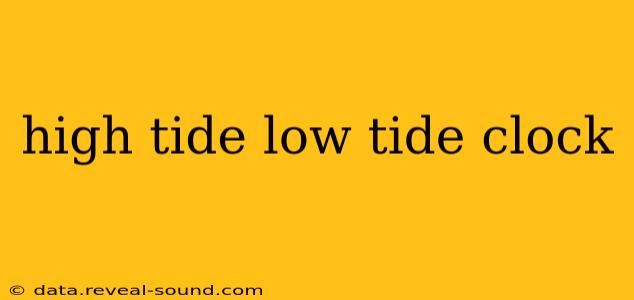The rhythmic ebb and flow of the ocean, the mesmerizing dance of high and low tides, has captivated humans for millennia. Predicting these tides accurately is crucial for coastal communities, mariners, and anyone enjoying the seaside. A high tide low tide clock, whether a physical device or a digital app, provides a convenient way to track these crucial tidal changes. But how do these clocks work, and what factors influence their accuracy? Let's dive in.
What is a High Tide Low Tide Clock?
A high tide low tide clock is a tool – be it analog or digital – that displays the predicted times of high and low tides for a specific location. These clocks are typically calibrated using tidal predictions generated from complex astronomical calculations and historical tidal data. They consider the gravitational forces of the sun and moon, as well as the shape of the coastline and the ocean floor, which significantly affect the timing and height of tides.
How Accurate are High Tide Low Tide Clocks?
The accuracy of a high tide low tide clock depends on several factors:
- The source of the tidal data: Reliable clocks use data from reputable sources like NOAA (National Oceanic and Atmospheric Administration) or similar organizations. Less precise clocks may use less accurate or outdated data.
- Location specifics: Tidal patterns vary significantly based on geographical location. A clock calibrated for one coastal area might be less accurate in another. Precise location input is crucial.
- Weather conditions: Severe weather events like storms or strong winds can disrupt tidal patterns, causing deviations from predictions. These are unpredictable anomalies.
While high tide low tide clocks aim for precision, they offer predictions, not guarantees. It's always advisable to consult multiple sources for the most reliable tidal information, particularly for critical activities like navigation or coastal safety.
What Factors Affect High and Low Tides?
Several factors combine to create the tidal cycle:
- The gravitational pull of the moon: The moon's gravitational force is the primary driver of tides. Its proximity to the Earth directly impacts the bulge of water we see as high tide.
- The gravitational pull of the sun: While less impactful than the moon, the sun's gravity also contributes to the tidal forces. When the sun, moon, and Earth align (during new and full moons), we experience stronger tides known as spring tides.
- Earth's rotation: The Earth's rotation on its axis contributes to the cyclical nature of tides, with high and low tides occurring roughly every six hours.
- Ocean basin shape and depth: The shape and depth of the ocean basin influence how effectively the tidal bulge propagates, leading to variations in tidal height and timing along different coastlines.
What is the Difference Between Spring Tides and Neap Tides?
This is a frequently asked question, so let's clarify:
- Spring tides: These occur during new and full moons when the gravitational forces of the sun and moon align, resulting in higher high tides and lower low tides. The tidal range (the difference between high and low tide) is maximized.
- Neap tides: These happen during the first and third quarter moons, when the gravitational forces of the sun and moon are at right angles to each other. The tidal range is minimized, resulting in smaller differences between high and low tides.
How Can I Find a High Tide Low Tide Clock or App?
Many options exist for finding high tide low tide information:
- Dedicated tide clock apps: Numerous smartphone applications provide highly accurate tidal predictions for specific locations. Many are free, while some offer premium features.
- Nautical charts and almanacs: These traditional resources often include detailed tidal predictions.
- Online tidal prediction websites: Various websites offer free access to tidal data, often with interactive maps.
- Local harbormasters or coastal authorities: These local experts can provide valuable information and insights specific to your area.
By understanding how high tide low tide clocks work and the factors influencing tidal patterns, you can better utilize this information for your coastal activities and appreciate the fascinating natural forces shaping our coastlines. Remember always to cross-reference your information with multiple sources for maximum accuracy and safety.
